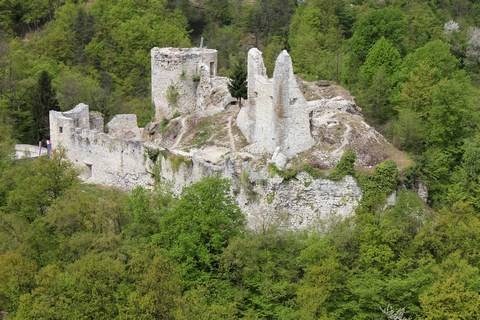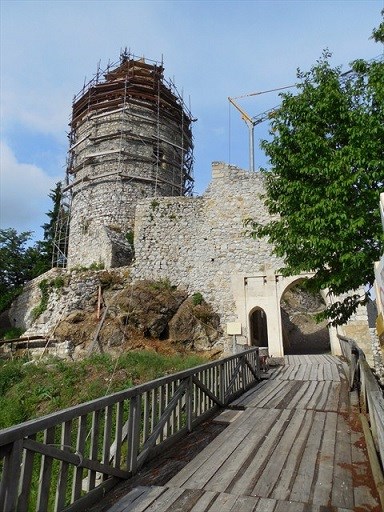Gospodje Žovneški, od leta 1341 grofje Celjski, so bili nedvomno ena najpomembnejših srednjeveških dinastij z izvorom in posestjo na današnjem slovenskem ozemlju. Od skromnih začetkov v Celjski kotlini sredi 12. stoletja so se v treh stoletjih povzpeli med državne kneze nemškega cesarstva, v sam vrh tedanje evropske plemiške elite. Pogosto pozabljamo, da je bila Barbara Celjska cesarica, Herman Celjski pa tast in najpomembnejši diplomat ogrskega, češkega in nemškega kralja ter cesarja Sigismunda. Zadnji predstavnik dinastije Ulrik II. je usmeril svojo energijo v veliko politiko v Avstriji, na Češkem in zlasti Ogrskem, kar pa se je tragično končalo z njegovo nasilno smrtjo leta 1456. Vsi trije potomci so mu umrli že v mladosti in tako je z Ulrikovo smrtjo zatonila tudi velika dinastija. Ostale so le tri zlate zvezde, ki v slovenskem državnem grbu še danes ponazarjajo slovensko državnost, pridobljeno že v srednjem veku.

Grad Žovnek je zagotovo eden najstarejših gradov na Slovenskem, Žovneški pa se v sedaj znanih listinah prvič pojavijo okoli leta 1130. Leta 1333 so Žovneški po odkupu druge polovice mesta Celje svoje upravno središče in bivališče preselili v Celje. Kljub temu, da je celjski grad postal novo upravno središče Žovneških, so ti ostali močno vezani na svoj matični grad in rodovne simbole. Grad Žovnek je ostal njihov družinski grad, na katerem so se kasnejši rodovi Celjskih grofov pogosto zadrževali.
Po nasilni smrti zadnjega Celjskega kneza Ulrika II. leta 1456 pri Beogradu je grad Žovnek, kot tudi ostala posest Celjskih, prešel v last Habsburžanov. Zadnji na gradu živeči lastnik je bil Jožef Čokl von Ruhethal, ki pa je leta 1816 v dolini zgradil novo graščino Ruhethal, grad Žovnek pa pri tem uporabil za kamnolom. Potem je bil grad prepuščen propadanju. Danes se nekdaj mogočni grad postopno obnavlja.

Vhod v grajski kompleks je urejen preko mostu skozi obnovljen dvodelni vhodni portal, ki je bil namensko ločen za pešce in konjenike. Osrednji del gradu je nekoč predstavljal stanovanjski del ali palacij, ki pa je danes skoraj v celoti porušen. Edina ostanka nekdaj mogočnega palacija sta dve t.i. "špici". Levo od vhodnega portala stoji najbolj markantni del grajskih ruševin, dvonadstropni okrogli obrambni stolp. Njegov osrednji del je bil nekoč v prvem nadstropju, v katerem je bila grajska kapela.
Kot je bilo značilno za tiste čase, so bili gradovi zgrajeni na težko dostopnih mestih, s katerih je bil izjemen pregled nad okolico. To velja tudi za grad Žovnek, s katerega je čudovit razgled na Žovneško jezero in celotno Spodnjo Savinjsko dolino vse do Celja.
DOSTOP:
Štajersko avtocesto zapustimo na izvozu Šentrupert, pot nadaljujemo do Braslovč. Tam zavijemo proti Gomilskemu, za naseljem Rakovlje pa proti Žovneškemu jezeru, nad katerim se dviga grad Žovnek. Avto pustimo ob kolovozu, na katerega nas usmeri kažipot ob cesti. Od parkirišča nadaljujemo naravnost po dovozni poti do gradu in nato pri kažipotu za Braslovče (Trailhead 2) nadaljujemo do zaklada.

[ENG]
Žovnek noblemen, since 1341 the Counts of Celje, were undoubtedly one of the most important medieval dynasties originating in today's Slovenian territory. From humble beginnings in the Celje basin in the middle of the 12th century, they climbed to the top of the then European aristocratic elite in only three centuries. We often forget that Barbara of Celje was the Empress, and that Herman of Celje was the father-in-law and most important diplomat of the Hungarian, Czech and German King and Emperor Sigismund. The last representative of the dynasty, Ulrich II., focused his energy on politics in Austria, the Czech, and in particular Hungary, which ended tragically with his violent death in 1456. His three descendants all died at a young age and so with Ulrich's death the great dynasty also came to an end. Only three gold stars remain of the dynasty, which in the Slovenian national coat of arms illustrate that the Slovenian acquired statehood already in the Middle Ages.
The castle Žovnek is undoubtedly one of the oldest castles in Slovenia, mentioned in written accounts for the first time around the year 1130. In 1333 the lords of Žovnek moved to Celje and the castle there became the administrative center of their entire domain. However, they were still strongly attached to their family castle and heraldic symbols. Therefore Žovnek remained their family castle, where the later generations of the lords spent a lot of their time.
After the violent death of Ulrik II. of Celje in 1456, the castle along with the rest of their property, became property of the Habsburg family as part of the inheritance. After 1816, when the last owners abandoned Žovnek and finally used it as a query, the castle was left to decay. Nowadays all that is left of it are ruins, which are being gradually restored.
The entrance into the castle compound leads across the bridge and through the two-way entrance portal, which was intentionally separated for horsemen and pedestrians. The central part of the castle was the palatium or the living quarters. The only remainders of the once magnificent palatium are the so called spikes. Left of the entrance is the most remarkable part of the ruin – the round defense tower.
As it was common in the past, all castles were built in areas with difficult access, but they had a spectacular view of the surroundings. The same goes for the castle Žovnek, which has a beautiful view of the lake Žovnek and the entire Lower Savinja Valley all the way to Celje.
ACCESS:
Leave the motorway Ljubljana - Celje at junction Šentrupert, and continue towards Braslovče. Once there turn towards Gomilsko and after the town Rakovlje toward Žovnek lake, above which rises the castle Žovnek. Leave your car by the road, to which you are directed by a signpost. From the parking spot continue straight on the access road towards the castle and from there follow the pathway to Braslovče (Trailhead 2) to the cache.
Viri:
www.gradovi.net
http://www.braslovce.si/dan-na-braslovskem-podezelju/gradzovnek.html
http://www.ljubljanskigrad.si/dogodki/2013/oktober/celjski-grofje/
Zloženka Kulturno zgodovinskega društva Žovnek Braslovče o gradu Žovnek
Če pa vas Žovnek in njegovi prebivalci še podrobneje zanimajo, priporočava knjigo Franca Kralja "Žovnek in Žovneški" iz leta 2000.